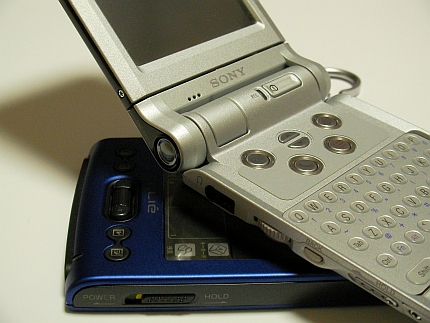Remember the Sony Clie PDA line? Yeah, the big flip-style ones. These were the HP Slates of the first half of the decade. Let me explain.
PDAs were the hot gadget item before smartphones. They instantly earned the owner geek credibility points and models were coming from nearly every manufacturer between 2000 and 2004. HP had the Jornada, and later the iPAQ after buying Compaq. There was the Dell Axim, the Linux-powered Sharp Zaurus, and of course the top-dog Palm Pilots.
Sony picked up on the trend and outed the Clie line that went toe-to-toe with Palm. These PDAs started out pretty much as premium Palm alternatives. They were more solid, came with a rich multimedia suite built into the Palm OS, but of course commanded a higher price. Over time Sony evolved the form factor while sticking with the Palm OS, although they hid the core OS with their own skin developed to better match the natural hardware controls.
Then out of the bowels of Nippon, the Palm OS 5-powered Sony Clie NX line dropped and nearly instantly, every 40-year old engineer feel in love. This massive beast took the PDA to its limits. It was like a Motorola RAZR, only five times larger, but — and this is big — it did a lot of things right. It featured a nearly usable chiclet keyboard that could be hidden by swiveling the large screen. There was a VGA still and motion camera along with a host of other features that are commonplace today, but were top-tier in 2002.
Awesome, right? Well, yeah, it was. But they didn’t sell in the states and Sony quickly made them exclusive to the Japanese market. But people didn’t buy them for the same reason the HP Slate isn’t headed for the consumer market: It was irrelevant.
I’ve said that Windows simply isn’t meant for tablets about a thousand and half times here. No matter how you slice it, it’s not. The interface was designed for mouse and keyboard input and no amount of touch enhancements can change that. However, the HP Slate, like the Sony NX line, is a necessary step forward.
Sony kept moving forward with their oversized clamshell PDA form factor for several generations. It was one of the first devices to show that the Palm OS was dated and not able to handle advanced tasks. Sony only made it worse by laying a complex skin overtop of it, which often caused the earlier models to lock up. Sony had the right idea, but the processing power and software platform wasn’t up to the task yet.
Look at Windows 7. It’s a less of a hog than Vista, but it’s still an OS designed to be run on a desktop OS. But there’s a very limited application library outside of Windows and so makers like HP will keep Windows around — application support was one of the chief reasons Sony stayed with Palm OS. Other tablets such as the ExoPC will skin Windows, but that’s only a temporary solution. Eventually Windows, like the Palm OS, will hit a point where it will no longer offer that many advantages over a proper mobile OS.
HP knows this. That’s why the company’s consumer tablet will run webOS. The average consumer doesn’t need a tablet to run Photoshop, some random inventory software, or Remote Desktop Connection. Nope, most people’s computer experience is almost entirely based around the web browser. A recent survey of iPad users show that 32% of owners have never even downloaded an app.
That doesn’t mean there isn’t a market for a Windows 7 tablet though. Nope, but where Sony kept their clamshell CLIEs around just for nerdy dads, HP is selling the HP Slate 500 exclusively to the enterprise market. That’s where the money is anyway. These folks don’t buy units individually, they buy them by the pallet. The same nerdy dads will still probably be able to buy a Slate 500 from various online sites, but they won’t be available from the usual retailers like Best Buy and Amazon.
The Sony CLIE clamshell line wasn’t the first of a generation. No, it was the last true evolution of the Palm OS platform even more so than the Treo smartphone that stuck around for a bit longer. This is where the HP Slate 500 sits. It’s the beginning of the end for Windows tablets.
